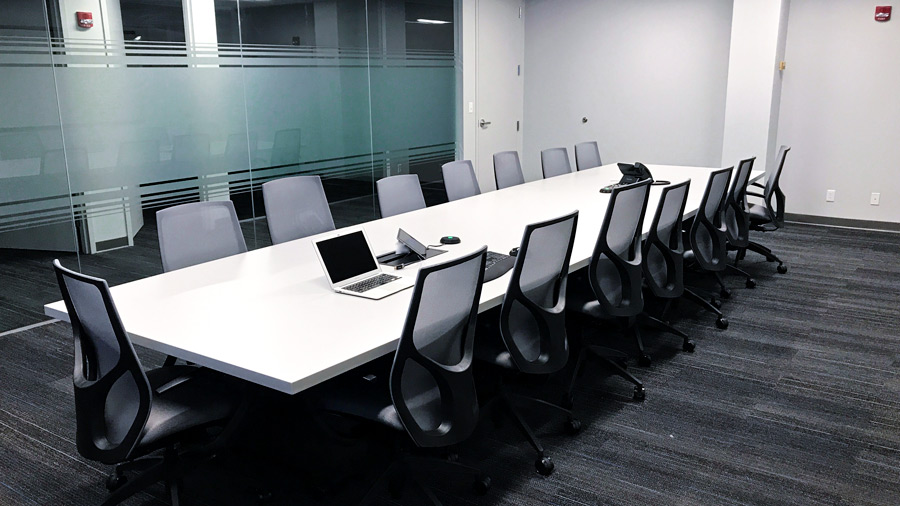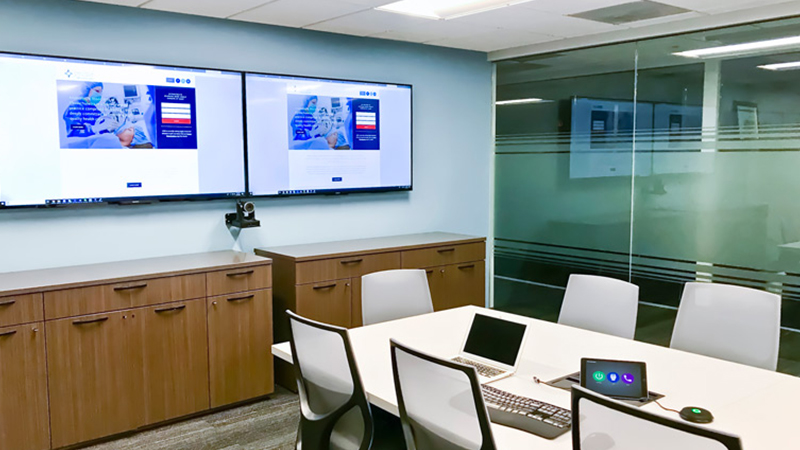Case Study: Anaesthesia Associates of Massachusetts
The Flourishing Complement of AV and Managed Services
Download the Case Study PDFAs AV and IT convergence accelerates, the benefits of All-IP solutions with outsourced system management bear fruit for end users like the Anaesthesia Associates of Massachusetts
Information technology has historically played a prevalent role in the day-to-day operations of the AV systems that live on the network. While systems integrators provide plenty of ongoing services and post-commissioning support, the “little things” – a projector going offline or an audio system going silent – often fall to the IT staff.
However, as more facilities transition to AV over IP-based systems, the benefits of the AV as a Service (AVaaS) are increasingly coming to the surface.
The Anaesthesia Associates of Massachusetts is one such example of an organization that has found value in transitioning to an IT-based AV operation with an AVaaS layer. Based in Westwood, Massachusetts, AAM built out new office space for its health care practice with a large 30-person conference and collaboration room. Along with presentation needs, a videoconferencing element was added to accommodate recurring meetings with AAM member doctors.
As a single-room system, there were plenty of reasons to consider a matrix-based AV solution that would support a specific number of inputs and outputs in that dedicated meeting space. However, an IP-based foundation would give AAM the operational flexibility, standards-based reliability, and ability to scale across a WAN or VPN as other conference rooms are added. This was also important to ensure flexibility from the AVaaS side of the equation.
“While the initial layout is a fairly modest set of AV features and components, the end goal was to provide system scalability, high levels of uptime, and centralized management,” said Nick Melin, president of AV/IT consulting firm AudioLogic, which handled the meeting space design and installation. “To realize those outcomes, we had to ensure that the AV technologies used were founded on IP standards, and would benefit from IT best practices, such as configuration management and infrastructure monitoring. This meant it was important to reduce reliance on proprietary solutions.”
To achieve these goals, Melin and his team specified and integrated an All-IP Meeting Space solution with four core elements across video (Atlona’s OmniStream AV over IP platform), audio (Dante networking), digital signal processing (Symetrix’s Radius AEC) and control (Atlona’s Velocity). This not only provided AAM with the core benefits they sought (flexibility, uptime, scalability), but left Greenpages well-positioned to remotely manage, analyze and troubleshoot systems as needed.
Designed to Adapt
The integration strategy wasn’t an IP-based design before Melin’s involvement. The original design called for tabletop connections from laptops to feed video through HDMI switchers to the displays, with soft codec video conferencing to enable connectivity. The AudioLogic and Greenpages teams knew that this original design would effectively hinder scalability and the AVaaS management strategy.
“We anticipate that new rooms will be added, potentially across geographically separated AAM facilities,” said Melin. “When that happens, the ability to efficiently redeploy a modeled AV solution to new rooms is paramount to minimize the cost of integration and commissioning time. We also wanted to ensure that AAM could add features or adjust services across the organization, without incurring significant downtime.We shifted the system design to an IT-centric approach to establish the necessary foundation.”
That shift put Melin and his team in touch with AAM’s IT department, a scenario that has become common as AV and IT convergence takes shape throughout the industry.
“With IT convergence, the AV devices become components of a living system that is maintained and adapted to a company’s changing requirements,” said Melin.
“More up-front coordination between the AV and IT experts is required when migrating to IP-based systems,” he continued. “We worked with them to ensure that subnets and VLANs were configured to support a flexible integration strategy. In the end, the system is more adaptable and can be maintained using tools that are familiar to IT professionals.”

“We had to ensure that the AV technologies used were founded on IP standards, and would benefit from IT best practices.”
– Nick Melin, president of AudioLogic
Traffic Management
The AudioLogic team developed a network segmentation plan to support separate VLANs. One subnet was created for OmniStream and Dante traffic, while VoIP traffic, including Skype, was assigned to a separate subnet. Both were separated from the main network carrying internet traffic and other data in the building. This was important for quality of service as well as security.
“The separate subnets ensure that the time domains for video and audio traffic are not impacted by PC traffic and WiFi devices,” said Melin. “Segmentation of the IP traffic also ensures that a video or audio stream cannot be received by a computer on the network that is not the intended end point. That is very important from a security perspective. We could have gotten away with less segmentation on a network this small, but following best practices is both safer and more efficient in the long term.”
A dedicated Cisco SG-300 switch accommodates all video, audio, voice and related VLANs in the space, with a straightforward backbone of Cat6 network cabling to move signals to and from the switch.
“The OmniStream AT-OMNI-232 networked audio interfaces convert analog signals into Dante streams, which simplified the prewire requirements,” said Melin. “Since everything routes through a switch, we installed additional network drops behind the displays and underneath the table. We utilized some of those drops to accommodate Dante inputs for additional microphones.”
The AV architecture includes nearly every product from the OmniStream Pro line, including the networked audio interfaces. AT-OMNI-111 single-channel and AT-OMNI-112 dual-channel encoders take in signals from a dedicated PC and two laptops, respectively. Out of the switch, an AT-OMNI-122 provides video and control signals to two Sony KD-70X690E 70-inch displays.
OmniStream USB over IP device adapters were also added to encode signals from an Atlona AT-HDVS-CAM PTZ camera, which is used for soft codec conferencing applications. The OMNI-311 USB to IP Adapter and OMNI-324 pair are USB 2.0 compatible and are a perfect match for HDVS-CAM.
Audio isn’t Overlooked
Audio for the room also utilizes the IP backbone, and incorporates a digital signal processor.Dante-based audio components work with OmniStream to provide a seamless audio integration.Shure MX396 microphones are connected to the AT-OMNI-232 audio interfaces and routed over IP to a Symetrix Radius AEC audio DSP. The Radius AEC optimizes audio quality for the room through echo cancellation, EQ, dynamics processing, and other features. Melin also added Dante Virtual Soundcard software on the dedicated PC to process Skype audio without requiring analog connections and adapters.
Melin notes that the Radius AEC was well-suited as the DSP solution for this space given Symetrix’s modular architecture, and interoperability with many IP-based audio solutions. The audio processing was straightforward to program using the Symetrix Composer software.
“Symetrix has a very large library of premade audio processing symbols that allow us to mix and balance the Dante signals exactly as needed,” said Melin. “This makes it simple for the end user to connect a laptop, begin a Skype call and speak naturally in the room. The DSP ensures that the presenter’s voice is clear and free of echoes, while the incoming audio is intelligible and pleasant for everyone in the room.”
The Radius AEC features a modular card-based architecture, which allowed AudioLogic to add a 2 Line VoIP Interface Card and connect that to the VoIP subnet for native integration to SIP-based calling platforms.
On the output side, the processed audio is re-encoded as Dante stream which is received by a plenum-rated Atlona GAIN-120 amplifier installed in the ceiling. Four QSC-AD-C820 ceiling speakers complete the audio signal path.

“More up-front coordination between the AV and IT experts is required when migrating to IP-based systems…In the end, the system is more adaptable and can be maintained using tools that are familiar to IT professionals.”
– Melin
Networked Control
The All-IP Meeting Space is tied together with Atlona’s Velocity networked control platform. The architecture uses a Velocity AT-VGW-250 Gateway control processor to manage all Atlona and third-party components in the ecosystem, with iPads used for the control interface.
Melin credits Velocity’s web-based configuration process for simplifying what could have been a challenging deployment process for his team.
“The OmniStream, Dante, and Symetrix components, which live on the same subnet, were able to discover each other. That quickly gave us a strong starting point. We then imported the audio controls into the Velocity platform via a Symetrix system file. Velocity’s menu-based configuration allowed us to quickly provide simple controls on the iPad UI.”
Melin notes that this installation was among the first Velocity deployments, and required some device drivers that didn’t exist yet on the Velocity platform. “Atlona’s developers were extremely helpful, and it’s refreshing to be working with a platform that was built with the Go programming language.We’ve already seen new features from Atlona since the installation was complete – such as the new Velocity API.”
“The Velocity and OmniStream configurations are version-controlled along with the Network configuration. This means we can rapidly deploy tested features to new rooms without extensive programming labor. We can roll back to previous versions if unexpected problems are encountered. This is made possible by Atlona’s powerful JSON API. If we scale to multiple buildings and rooms with hundreds of devices on the network, we’re well-positioned to move to Velocity’s cloud architecture.”
Managed Services
Velocity will also be used on the AVaaS layer for monitoring purposes, according to Joshua Dinneen, president of digital transformation, Greenpages.
“We’re tapping in at moments to make corrections specific to the device that is reporting trouble,” said Dinneen. “We can fix most issues remotely, though we’ll open a ticket with the manufacturer if there is a known bug or an operational issue that prevents us from creating a workaround. Once we have a remediation plan from the manufacturer, we add it to the knowledge base and can repeat those fixes as necessary.”
Greenpages initially came onboard with AAM to support a broader organizational need that involved its CIO on Demand Services. AAM, which was divesting from its former parent company, hired Greenpages to execute an overarching business strategy. Separating IT services from the parent company was a substantial strategic component.
“We established an infrastructure to support their new IT strategy, such as installing a new phone system and moving their email service to the cloud,” said Dinneen. “In alignment with what we now see taking shape in the AV industry, they soon asked us to help them strategize that component of their business. The All-IP Meeting Space was an aspiration of their CEO and represents how they intend to run their audio-visual operations moving forward.”
Along with the new opportunities that come with migrating AV systems to the network, organizations also have an easy way to outsource operation and maintenance elements to a service provider. AAM’s decision to outsource to Greenpages removes the responsibility of systems management and troubleshooting from internal staff.
Greenpages’ CMaaS platform is the basis of its AVaaS strategy for AAM. CMaaS, an acronym for Cloud Management as a Service, integrates with a more comprehensive set of off-the-shelf IP tools to cover both the proactive and responsive needs around remote management.
As Dinneen explains, the platform provides a full document of AAM’s conferencing and collaboration environment. Greenpages creates what they refer to as a “knowledge-based system” that allows them to understand all the parts and components in the system – and if and how they interoperate.
“We can map the dependency that each component has on others across the AV and IT ecosystem,” said Dinneen. “For example, during a videoconference we have a view on the health and status of each circuit. If the carrier has an outage or the platform is not open, we may need to open a ticket; if it’s a firewall or router issue, we can remediate that from another control center. The overarching benefit for AAM is that they have an organization in place to manage their environment, which allows them to allocate internal resources for other responsibilities.”
Like the AV system itself, Dinneen notes that the Greenpages CMaaS platform is an associated IP toolset can scale with AAM to address needs in other rooms and locations.
Melin adds that the AAM project ideally represents where the industry is headed, and the value that a combined integration and managed service strategy can bring to the end user environment.
“To generate real business value from the AV/IT convergence, solution providers should pay close attention to the recent history of the IT industry, where open standards, automated deployments, and continuous improvement are now table stakes for the leading organizations.We think that the AAM project offers a strong blueprint to build from as the AV industry heads further in this direction.”
“Along with the new opportunities that come withmigrating AV systems to the network, organizations also have an easy way to outsource operation and maintenance elements to a service provider. “
– Melin
| PRODUCTS FEATURED | PRODUCTS FEATURED |
| Model | Description |
| AT-GAIN-120 | Compact power amplifier designed for low or high impedance applications. |
| AT-HDVS-CAM | Enterprise-grade PTZ camera designed for use in soft codec conferencing applications |
| AT-OMNI-111 | Networked AV encoder for one HDMI source up to 4K/UHD, plus embedded audio and RS-232 control |
| AT-OMNI-112 | Networked AV encoder with two independent channels of encoding for two HDMI sources up to 4K/UHD, plus embedded audio and RS-232 control |
| AT-OMNI-122 | Networked AV decoder for an OmniStream-encoded video stream up to 4K/UHD, as well as embedded audio and RS-232 control |
| AT-OMNI-232 | Networked AV decoder with two independent channels of decoding for two OmniStream- encoded video streams up to 4K/UHD, as well as embedded audio and RS-232 control |
| AT-OMNI-311 | USB to IP Adapter |
| AT-OMNI-324 | IP to USB Adapter |
| AT-VGW-250 | AV control processor for the Atlona Velocity Control System |
| AT-VTP-800 | 8" Touch Panel for Velocity Control System |







